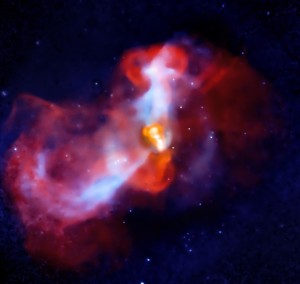
M87 derives its name because it was item 87 on french astronomer Charles Messier‘s 1781 catalogue of 103 objects that had a nebulous appearance.
Now, lets make this clear, you are not looking at an exploding star, this is an entire galaxy you can see here.
The cluster surrounding M87 is filled with hot gas glowing in X-ray light (and shown in blue) that is detected by Chandra. As this gas cools, it can fall toward the galaxy’s center where it should continue to cool even faster and form new stars.
However, radio observations with the VLA (red) suggest that in M87 jets of very energetic particles produced by the black hole interrupt this process. Oh sorry, did I forget to mention that this galaxy has a a supermassive black hole at its core. Anyway, these jets lift up the relatively cool gas near the center of the galaxy and produce shock waves in the galaxy’s atmosphere because of their supersonic speed. The interaction of this cosmic “eruption” with the galaxy’s environment is very similar to that of the Eyjafjallajokull volcano in Iceland that occurred a few months back and turned all of Europe into a no-fly zone.. With Eyjafjallajokull, pockets of hot gas blasted through the surface of the lava, generating shock waves that can be seen passing through the grey smoke of the volcano. This hot gas then rises up in the atmosphere, dragging the dark ash with it. This process can be seen in a movie of the Eyjafjallajokull volcano where the shock waves propagating in the smoke are followed by the rise of dark ash clouds into the atmosphere.
In the analogy with Eyjafjallajokull, the energetic particles produced in the vicinity of the black hole rise through the X-ray emitting atmosphere of the cluster, lifting up the coolest gas near the center of M87 in their wake. This is similar to the hot volcanic gases drag up the clouds of dark ash. And just like the volcano here on Earth, shockwaves can be seen when the black hole pumps energetic particles into the cluster gas.
Now who said that science was dull.
Image Credits: X-ray: NASA/CXC/KIPAC/N. Werner et al Radio: NSF/NRAO/AUI/W. Cotton
If you want to get a closer look, just click on the picture above.